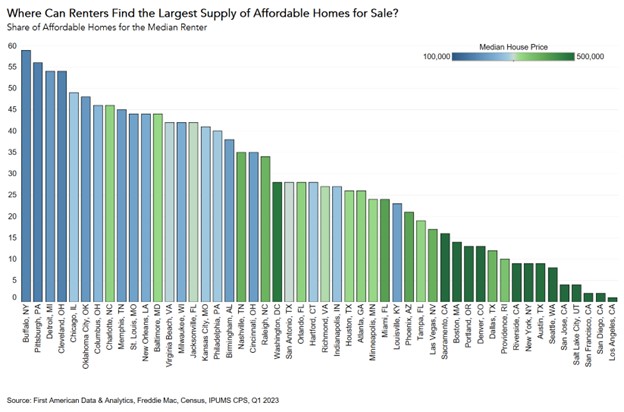National housing affordability has broadly declined compared with one year ago, especially for potential first-time home buyers. The median renter, who can also be considered the median first-time home buyer, could afford 34 percent of the homes for sale nationally in the first quarter of 2023, down from 45 percent a year earlier. The decline is primarily due to a sharp increase in mortgage rates. The 30-year, fixed mortgage rate averaged 6.4 percent in the first quarter of 2023, an increase of almost 3 percentage points over the average mortgage rate in the first quarter of 2022. As a result, national renter house-buying power declined by 22 percent compared with a year ago, from $302,000 to $237,000. While median house prices declined by 3 percent over the same period, that decline was not enough to offset the impact of rising mortgage rates. Mortgage rates are a powerful driver of affordability, but incomes and house prices also make a difference, especially on a market-by-market basis.
“The affordability outlook is mixed, but there are markets that remain affordable for the potential first-time home buyer, like Buffalo, Pittsburgh and Detroit, despite the turbulence of today’s housing market.”
First-Time Home Buyer Affordability Depends on Two Factors
For potential first-time home buyers, who by definition are renters, affordability is a function of their house-buying power and the corresponding share of homes for sale that are within their reach. A potential first-time home buyer’s house-buying power – how much home they can afford – is based on renter household incomes, the prevailing 30-year, fixed mortgage rate, and the assumption that one-third of pre-tax income is used for a mortgage with a 5 percent down payment. The share of homes for sale that are affordable to the median renter in any given market is estimated by comparing data on home sale transactions from First American Data & Analytics to the median renter’s house-buying power.
An affordable market is a market where the median, or 50th percentile, renter can afford 50 percent or more of the homes for sale. If a potential buyer can afford their “share” of homes for sale, it suggests that there is enough supply at the right price to meet demand. Using that definition, home buyer affordability can be compared over time and between markets.
Where Can First-Time Home Buyers Find the Greatest Supply of Affordable Homes?
Nationally, by this measure, only four markets were affordable to the median renter in the first quarter of this year: Buffalo, N.Y., where 59 percent of homes were affordable to the median renter, Pittsburgh (56 percent), Detroit (54 percent), and Cleveland (54 percent).
The least affordable markets were Los Angeles (1 percent), San Diego (2 percent), San Francisco (2 percent), Salt Lake City (4 percent), and San Jose, Calif. (4 percent). While the four California markets have traditionally been some of the least affordable, Salt Lake City is a newcomer to the list. Pre-pandemic, Salt Lake City was an affordable market that fell in the middle of the pack out of the top 50 U.S. markets. However, rapid house price appreciation during the pandemic dragged Salt Lake City near the bottom of the affordability list. In the fourth quarter of 2019, the median renter could afford 69 percent of the homes for sale in Salt Lake City. Now, the median renter in can only afford 4 percent of homes.

Where is Housing Affordability Headed?
The future trajectory of housing affordability is uncertain. House price appreciation had been decelerating since April 2022, but re-accelerated on a monthly basis in February, the latest data available, according to the S&P Case-Schiller Index. The current supply of homes for sale is limited, in large part because existing homeowners are rate locked-in to historically low mortgage rates and don’t have a financial incentive to move. Home builders are adding fresh inventory, but not enough to meet demand. Limited supply against high demand puts upward pressure on house prices and, in turn, downward pressure on affordability.
On the other hand, the Federal Reserve has signaled that they might pause interest rate hikes, which may lead to an easing in mortgage rates. That would give potential first-time home buyers some relief. The affordability outlook is mixed, but there are markets that remain affordable for the potential first-time home buyer, like Buffalo, Pittsburgh and Detroit, despite the turbulence of today’s housing market.


.jpg)
